I got sad news this week. I have to say goodbye to an old friend. If ever a person were in love with an inanimate object, I have loved my van, the Kerouac-mobile… the K-man, or just K, which the most recent visit from the AAA mechanic revealed is now past being worth fixing. It’s just as well since it’s no longer practical for my regular city needs. But then, it was never meant for such mundane purposes, or even the not-so-mundane construction duty that he was unwillingly hauled into after Hurricane Katrina. He was meant as a live-in open-road archaeologist’s research vehicle, born of my dream, together with my Cajun grandmother, of a road trip to the ancestral lands of her Acadian forebears, Nova Scotia. Originally a Navy personnel transport vehicle, I put on a high-top with an A/C, tinted all the windows, installed all manner of power sources and converters, then after taking out all the seats but the driver’s, put in a tiny bed, fridge, microwave, portable toilet, water tank, and then a huge desk on file cabinets for my computer equipment and research materials. In a tongue-and-cheek gesture of homage to the 4000 sq. feet of historic Garden District grandeur I was exchanging for a 6×15 box on wheels, I lined all the panels in a fine brown-and-gold Indochine-print toile (to the amusement of girlfriend Susan who graciously lent me her living and diningroom floors for the task), put ornate denticulated molding around the shelving, satin drapes between the three ‘living sections’ with lace curtains over the windows, and plush brocade and faux mink covers on the bed. With the final touch of chandelier crystals around the overhead lights, I dubbed the style Italianate meets Early Red Light District.
____________________________

It took 5 days to drive from New Orleans to Nova Scotia, and I thought that the adventures wouldn’t begin until I got there. I was wrong. Somewhere in the Blue Ridge mountains, I started getting honked at and harassed by an 18-wheeler, who I refused to look at or even meet eyes with. It went on for over an hour. Finally, I noticed a sign for a rest stop that didn’t admit 18-wheelers, and I took it. It sloped down into a pretty ravine and I figured it was a nice enough place to stretch out and take a potty break. Next thing, this guy comes down the hill through the grass, on foot, yelling at me. I can see his rig way up above us on the shoulder of the highway, something those big rigs are not allowed to do. He’s all mad, yelling stuff about “…been trying to get your attention for 2 hours…” and “…got a hammer bouncing around loose up there that’s gonna fall into someone’s windshield and get people killed…” Oh, God! I hawled myself up the front fender and windshield, and sure enough! In just that time, though, a state trooper had stopped in front of the rig to write a ticket and the guy, after one last dagger-filled lear, started back up the hill saying something like “I knew she was gonna be trouble”. It took a while to grab the hammer, then scramble back down, but then I barreled up the steep hill so fast that by the time I got to the cop, huffing and puffing, I couldn’t talk. He looked at me blankly. Finally, in between gasps for air, I blathered a high-speed stream of “…my fault…he tried to tell me… hammer, could’ve killed someone… ignored him for over an hour… couldn’t come down here with the rig… could be he saved someone’s life… all my fault… and PLEASE DON’T GIVE THIS MAN A TICKET!”
He didn’t say anything for a while, just looked between me, his ticket book, and the driver who was by now bent over, his hands on his knees like a beat dog. Then he folded his ticket book and put it away, told us he’d escort us to the state line, and then left. That was that. Or so I thought. Hours later at a truck stop, I was eating in a section that said truckers only when I noticed a table of truckers looking over their shoulders at me, not smiling at all. I figured they didn’t want some silly little chick intruding on their domain, and when they all got up and came directly toward me, I hastily planned a profuse apology and exit strategy, except that they blocked the booth I was in. One of them sat down across from me. “You the girl with the white hightop goin’ to Canada, Luziana plates?” I held my breath, then nodded. “It’s all over the radio about some girl got a trucker out of a $300 ticket, saved his job, heading for Canada up I-95, and to watch out for her til she gets to the border.” We chatted for a couple minutes about what I was doing, the road trip, looking for one of my grandmother’s Acadian ancestors who came to Louisiana, whose farm my grandmother would 150 years later be born on. And for the next 2 days, til I got to the border, I got ear-splitting diesel blasts from truckers, and met every one of them in the eye with a wave. Truckers aren’t what most people think, and truck stops aren’t either. But that’s another story.
____________________________
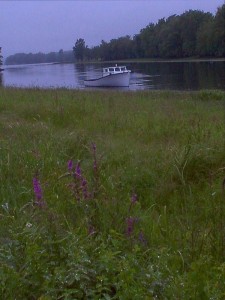
The first official stop of the road trip was Jemseg, an early 1600s trading post on the St. John River, which is on the west side of the big Bay of Fundy. Its short history mirrored the rest of Acadia, being owned back and forth between the warring English and French, and suffering the same fate of failed crops, floods and harsh winters that ended so many of the earliest settlements before Port Royal was finally founded on the east side of the Fundy. There’s nothing left of it in the tiny rural community of green pastures and woods by the side of the river except a 1929 monument on a bluff overlooking the river where the fort is thought to have been, but it was meaningful to me, had glorious strawberries at a little roadside grocery across from an old abandoned wood church covered in vines that was surely on a postcard somewhere, and a lovely secluded spot by the river in which to commune with K for our first fireside evening in the wilderness. Snug under the covers, I opened the back doors out onto the remains of the fire and fell asleep. At dawn, with the cold morning’s fog still hanging over the water, a lone forgotten boat half full of water, drifting lopsided on its mooring, greeted me from outside my lace curtain when I opened my eyes.
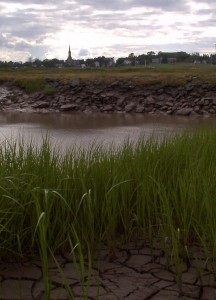
I first saw the red clay of the famous Fundy tides, the highest in the world, after leaving the University of Monkton’s Acadian research facility and traveling down the Petitcoudiac River. And it wasn’t long before I caught the magic of those tides, and saw firsthand the role they played in the lives of the Acadians. By the time I reached the tiny community of Chipoudy (spelled Shepody today), one of a string I’d passed along the river, it was night and I had been looking for a bar or restaurant or music hall for a long time, anything public where I could talk to someone. Town after town, I never saw a single soul outdoors. Finally, I saw two guys in front of a fire station, sitting out under the quiet night sky on folding chairs. “Where can a girl get a drink after a long day?” “Three towns back” came the answer. “Where do people drink around here?” “Home.” Toto, we aren’t in New Orleans anymore.
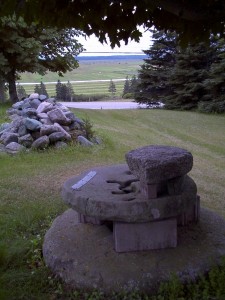
They did, however, have the name and number of a man who was the unofficial town historian. And the road trip gained momentum. When I met with him the next day, he not only knew of Pierre Thibodeaux, my 13x great grandfather who had founded Chipoudy in the 1690s, but knew where his sites were and agreed to show me around. He knew where Thibodeaux’s mill had been and where remnants of his dikes could still be found down in the valley. And he had found his millstone years before and had hauled it out and set it in his garden. This was the first thing he showed me the next morning before taking me for a hike up a wooded creek to where the mill had been, a small falls clogged with moss-covered branches, at the base of which was a widening of the creek bed where the mill wheel had lain for a good 250 years. When he was a kid, he said, there had also been all sorts of metal fitting strewn around, but they disappeared in the 40s when scrap metal was collected everywhere for the war effort.
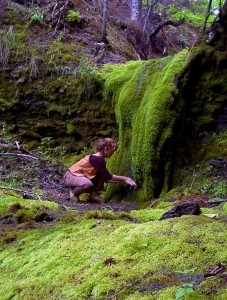
Then, back down the hill, we following the same creek down into the valley, tromping through pastures, over barbed wire, and around an irritable bull or two, until we reached where one of Thibodeau’s aboitteaux had been. (An aboitteau is a wooden conduit laid under a dike or levee at the fringe of a floodplain, usually in the bed of a creek, with one-way flaps at each end, like valves, that let fresh water flow out to sea during low tide, but don’t let salty sea water in at high tide. It was usually made from two halves of a hollowed out log, one upside down on top of the other, with little flanged doors at both ends fitted into the upper piece.) His dike, once around the very rim of the valley he created, was now far inland, as post-WWII earth-moving tractor plows had enabled farmers to extend their fields much farther out into the sea than in Thibodeaux’s time, and for this reason, their were few places where Thibodeaux’s old dike hadn’t been plowed under. But around the little creeks that ran down from the mountains on the other side of the highway, remnants of them remained, and it was one of those where my guide brought me, which I later found on a map had been a part of the 1697 construction period, one of 3, by Thibodeaux and his four oldest sons. Where the creek now bisected the section of Thibodeaux’s levee on which we stood, an aboitteau that had long since been consigned to the sands of time and the sea had once lain, flushing the sea’s salt out with the rainwater. The aboitteau, the signature tool of the Acadian farmer to reclaim salt marshes, was uniquely suited for the monster tides that rushed up and down the Bay of Fundy’s tributaries twice a day.
.
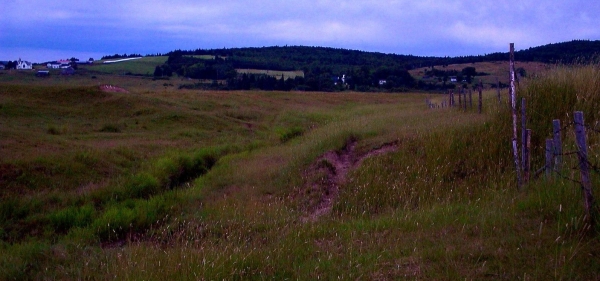
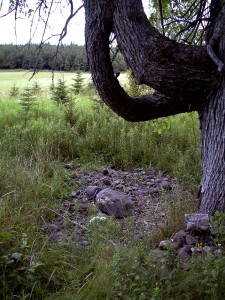
.
.
.
.
.
.
.
One of the last things my guide showed me was a cellar site that he remembered as a child being empty but had since been filled with stones cleared from a nearby field. It had been the home of the girl who sounded the alarm in 1755 when she saw off in the distance the sails of the British ships coming in for their last attack, ringing the church bells that gave their village enough time to escape into the woods while the British ships were stranded out on the mud flats by the outgoing tide.

The Acadians were intimately familiar with the tides, which came in and out exactly 12 hours and 26 minutes apart, and could plot high and low tides months ahead of time. It was one of the greatest frustrations for the British who, ignorant of the tides’ schedule, could never execute a sneak attack. Visible for miles as they lay in the mudflats waiting for the next tide, they could never capture the villagers, and had to content themselves with burning their homes and crops and breaking open the dikes.
I wanted to explore the valley more at both high and low tides, especially the modern aboitteaux, but there was only one road that penetrated the valley all the way to the water’s edge, and it was not conducive to K’s size. So I rented a horse from a nearby stable, twice, at high and low tide. Not sure how K felt about that.
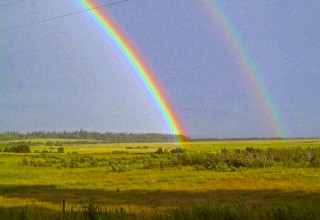
.
.
During this time the weather had been gloriously cool and blue, with no humidity, which made for glorious exploration, but on my last afternoon it showered for an hour or so which gave me an opportunity to make some headway on the day’s field notes. It was one of those showers where the sun never really gets fully covered, and its rays glisten off the droplets in the air. When I was finished with my writing and ready to take the road trip back on the road, I got out to stretch my legs, looked out across Thibodeau’s dikes whose colors had been freshly washed, and this is what I saw.
.
.
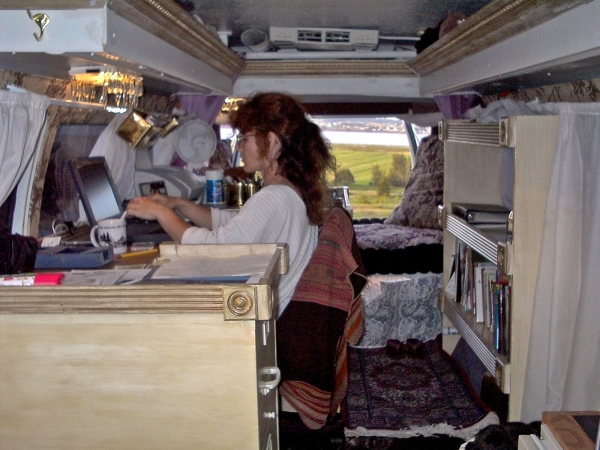
So many wonderful hours writing in my cocoon, doors open to such beautiful unspoiled patches of nature. So many hours reading in bed, pouring over archaeology reports given to me by museums and research facilities, and books I’d found in Monkton. Once a week, I sent an abbreviated week’s diary to my grandmother, printed out in large type, and 5×7 photos of me in different places. She had warned me that she only wanted shots with me in them, not a roll of anonymous landscapes, so I became a master of my camera’s self-timer. It meant so much to me to share this with her. She was 95 but still quite sharp.
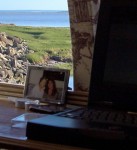
.
She was, as she has always been, my muse.
.
.
So many wonderful campfire-cooked meals with the K-man.

.
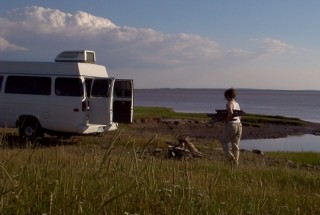

.

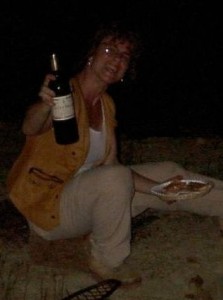
.
.
.
.
.
.
.
The Maritimes have a wonderful tradition, the Friday lobster supper, which is reasonably priced with lots of other good things besides the lobster you get, and lots of people at the communal tables to talk to. But for the most part it was salmon or scallops from the local markets (exquisite) and wine from local vineyards (better than expected), then a soapy river-sand cleanup for the dishes and a Baby Wipes bath for me with a nice hot bowl of water from the microwave. Often I was camped by a clear river or stream where I could swim and wash my hair, and when I visited the truck stop to do laundry, I’d also rent one of their shower suites which were roomy, industrially sanitized, and locked like Fort Knox. But the Baby Wipes and hot water rinse before bed became a favorite ritual. “The archaeologist’s bath” I started calling it.
____________________________
From Fort Beausejour, the road trip continued across New Brunswick’s border into Nova Scotia, and the TransCanada deposited me in Truro, a good-size town which had begun as the Acadian village of Cobequid and served as the gateway to the Minas Basin. The Minas is ringed all around by rich red-clay tributaries which the Acadians settled starting around the 1680s and early 90s when British hostilities in Port Royal, Acadia’s primary settlement founded some 50 years before, had begun to make life too difficult. It was the same with Pierre Thibodeau and his oldest sons, who made the decision to build a new homestead in the late 1690s even farther away, across the Fundy, on the fertile marshes of a mountain that he would name Chipoudy, a corruption of the French Chapeau de Dieu, ‘God’s hat’. The inspiration must have come to him in autumn, when the leaves are a stunning array of colors, including some I’d never seen on a leaf before, like electric hot magenta. (We don’t really have autumn in New Orleans. It’s humid; things just go from green to brown, then rot.)
( ♫ ♪ Where’s K? ♬ ♩)
(When I looked back over my Minas Basin photos and saw K in several of the shots, the children’s book ‘Goodnight Moon’ came to mind. I used to love to play ‘Where’s the mouse?’ with my grandmother. He was there in every drawing.)

.

.

.
.
.
.
.
.
.
.
.
.
.
.
.
.
.
.
.
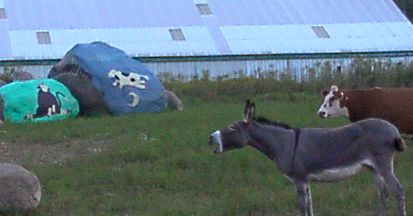
Getting K through the patchwork of farmlands where Landry’s village had been wasn’t easy, as there was only a narrow dirt road weaving through them and few places wide enough to turn around. I kept fearing that I’d run out of road and have to back K up through it all to get back out. Plus, with directions from people to supposed cellar sites too vague to actually find anything, it wasn’t that productive. But there was a show in store that made all of K’s struggles worthwhile, because no road trip is complete without its surreal moments. On the slow way back along the circuitous pitted path, I heard from my open window the braying of a donkey, and seconds turned to minutes without him letting up. What in the world kind of commotion could possibly be happening to this guy? I envisioned hooves flying and all sorts of people yelling, some pulling on ropes, some flying through the air. As I drew closer to the sound, I spied two very unnaturally colored boulders which turned out to have been painted by someone who must have had kids; one of Ferdinand the bull and the other of the cow who jumped over the moon. Standing in front of them was a donkey, standing still, completely alone in a field except for a brown and white cow who was just looking at him, having nothing done to him, braying, at nothing in particular, non-stop without hardly even taking a breath. Not even a huge white van lumbering down the tiny path and a nosy girl with a camera gave him pause.
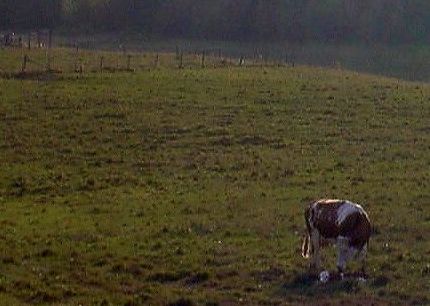
When I finally left, not 60 seconds down the path in the next field, I saw another brown and white cow standing over something on the ground, a patch of brown and white like herself that wasn’t moving. She licked it for so long, like she were trying to will it back to life, until all the mirth and amusement I’d just felt a few minutes emptied out through my eyes. How could this quiet little tiny tragedy, witnessed by no one but me and God, be going on right next door to the surreal scene I had just left. My mind kept telling her to stop, to move on and forget, as I wanted to do, but I didn’t want to leave her alone. I wanted someone with her, to feel it with her. Finally, though, I told K to take me away, cringing for the first time at how loud and irreverent his engine was, but out of the corner of my eye I saw something that made me stomp on the brake abruptly enough for a few things to fall off a shelf behind me. A tiny white face drunkenly lurched up from the patch of fur on the ground. And then the tears really let loose. I don’t know how long I stayed, watching the little guy try to get his little toothpick legs to hold him up, and then stand, and then walk, and then follow his mother as she very slowly led him up the hill to the barn, home.
This place… Fellini wouldn’t even have to write a script.
.
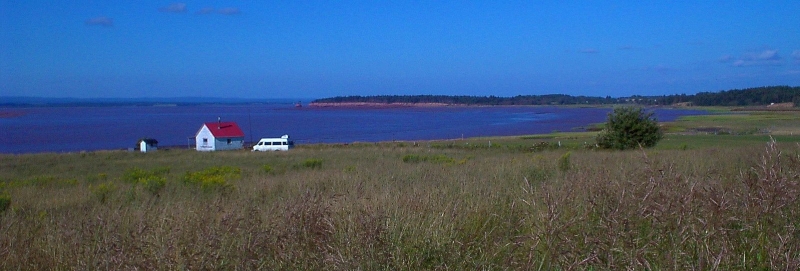
.
.
.
.
.
.
.
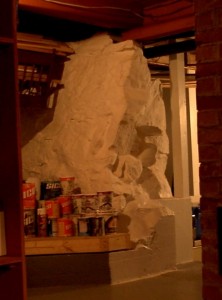
And I guess a road trip has to have a good mystery or two, as well. It was in Selma that I started putting 2 and 2 together about something no one was talking about. All the old timers I interviewed were very welcoming, and spoke of vivid memories playing as children in the fields where Acadian cellar sites, toppled cemetery headstones in French and ‘old French dikes’ were still plentiful in the Minas valley, and hand ploughs could only go around them. They jumped in my van and took me up and down the river, telling me wonderful stories and pointing out spots where things used to be. Not anymore, though. They explained that by WWII, new tractors were able to plow everything under and flatten out the old dikes, allowing for continuous and uninterrupted swaths of cropland. I noticed that no one was pointing out where the cemeteries had been, and when I asked, suddenly no one could remember. I said to just show me the ones they had already told me about, but still they said they ‘couldn’t remember’. I realized that these were descendants of the Scots and British whom they knew had been given lands that had been taken away from the Acadians. Their ancestors had no allegiance to the Catholic religion or the sanctity of its holy ground, and further, knew that reporting a cemetery site to the government meant forfeiting crop acreage. It must have been a terribly uncomfortable position for them, to have someone coming to look for their ancestors’ graves. One man from the area was not of British heritage but Acadian, whose family had moved back to the area after 200 years in Cheticamp on the rocky infertile cliffs of Cape Breton where their ancestors had fled as refugees in 1755. He showed me with such pride, down in his basement, how he and his wife had incorporated the walls of an Acadian cellar into the basement of their house. He also told me what it felt like when he realized that it was his own friends and neighbors, and their parents, who consciously and secretively plowed under his ancestors in their holy ground and consigned the memory of their final resting place to oblivion.
_____________________________